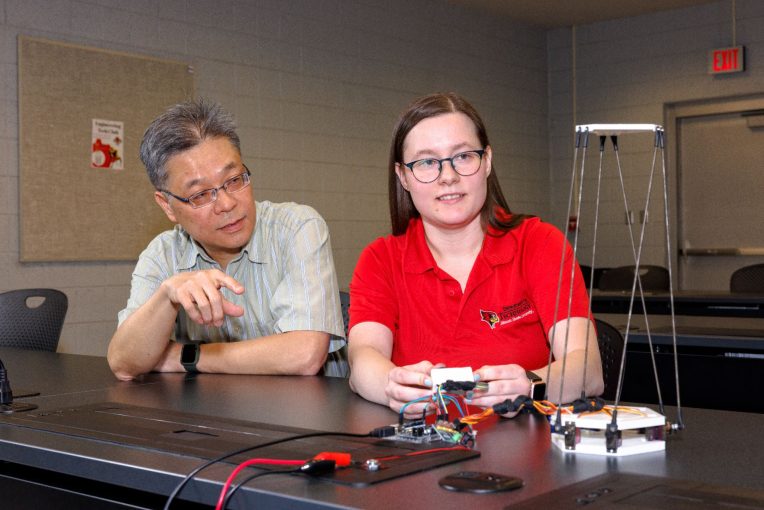What if you could design something—using virtual reality (VR)—that would help novice drivers become better and safer on the road?
To do that using a VR driving simulator, there is the risk of cybersickness for users. Cybersickness, similar to motion sickness, has symptoms that can include nausea, visual and general disorientation, all due to sensory conflict that occurs when there is no physical motion.
Thanks to the help of a BirdFEEDER Grant, Dr. Isaac Chang, associate professor in the Department of Technology, with the assistance of his then-graduate assistant, Savanah Kinney ’21, M.S. ’23, have designed a desktop Stewart platform to alleviate the cybersickness problem in VR-based driving simulation.
Stewart platforms allow users to experience realistic simulations and have many applications, including in flight simulators or, in the case of Chang’s research interest, in driving simulation. Chang and Kinney worked together on the project for about a year.
“I did this for my independent study both fall and spring, so I started in fall 2022,” Kinney said. “The purpose of this is to mimic body movement that would happen in real life when driving a vehicle, for example, but you’re wearing a VR headset.”
Kinney said VR users can experience conflicting sensory issues when they see or hear an input happening in their VR immersive environment as they sit stationary. She and Chang wanted to eliminate those conflicts that cause cybersickness.
“It’s similar to seasickness because you cannot predict the boat’s movement,” Chang said. “When you are in a car, the driver doesn’t usually have issues with carsickness, but the passenger might because they don’t know where the driver is going. And the faster the scenario moves, the easier you can get sick.”
“We can have a great VR environment where it looks very real to what would happen on the road, but if users are getting sick or feeling discomfort during their VR experience, that data might not be valid.”
Savanah Kinney
Kinney did some coding and built a program that specifically controls the X-axis and Y-axis of the Stewart platform. The work, she said, was closely related to her undergraduate training in engineering technology.
“We know that we can move it and manipulate this platform in a way that would translate into the real world and do what vehicles do,” she said. “But if I had not gone to ISU for my undergrad and learned what I had learned, I wouldn’t know how to do any of this stuff.”
Chang selected Kinney to collaborate on the project because of her technical expertise.
“I have an idea how to do all these things, but to realize it I had to find a specific person,” Chang said. “She was willing to take on a challenge, and that part was critical.”
Chang and Kinney have designed a compact, desktop version of a Stewart platform. Chang described it as a “Matchbox car” in size. But that was by design, he said.
“This is a proof of concept to show that it works,” he said. “We’re developing the platform specifically for novice drivers’ safety.”
Chang thinks that a life-sized prototype with different learning modules will be ready in the near future. This generic platform could eventually be used with the façade of specific car models.
“Maybe it could be used as a Toyota Corolla now, and tomorrow it could be the Ford F-150,” Chang said.
“We can have a great VR environment where it looks very real to what would happen on the road, but if users are getting sick or feeling discomfort during their VR experience, that data might not be valid,” Kinney said. “Companies want valid, usable data from users in the most realistic scenario possible when making decisions that impact their business.”
Kinney, a former Bone Scholar, said she acquired many of her skills during her undergraduate experiences studying engineering technology and being part of the ISU Solar Car Team. She came away with a wealth of experiences, including learning about automation, product design, and technical project management, among others. She recently started her career as an associate industrial engineer with Bridgestone Americas in Normal.
Chang likes to have students, such as Kinney, involved in his work. He said their nimble brains and technological aptitude fit his research well.
“I tell students that I’m recruiting them to solve my problems,” Chang said.
Kinney was more than up to the challenge and made the most of her time working with Chang, including attending a national conference. She presented at the Illinois State University 2023 Research Symposium and last fall’s Association of Technology, Management, and Applied Engineering (ATMAE) Annual Conference in Louisville, Kentucky.
Chang said support from Dr. Gina Hunter and the Office of Student Research (OSR) was crucial to the project’s success.
“Savanah was awarded an OSR BirdFEEDER grant for purchasing the material, as well as OSR’s travel grant to present at the ATMAE conference,” he said.
Kinney said Chang was more than generous in helping her succeed in his lab.
“I was given so many resources, so I wasn’t just left to do it all my own,” Kinney said. “It was a great opportunity.”

